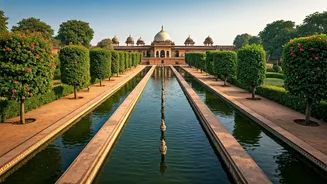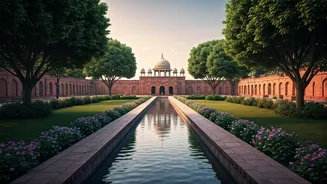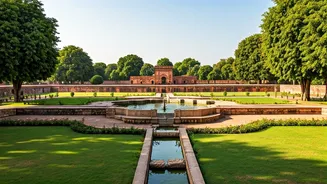Shalimar Bagh, Kashmir
Shalimar Bagh, located in the heart of Kashmir, stands as a premier example of Mughal garden design. Constructed by Emperor Jahangir for his wife Nur Jahan in 1619,
the garden is a masterpiece of symmetry and natural beauty. It's laid out in a series of terraces, each leading to a central water body, reflecting the sky and the surrounding scenery. The garden's strategic positioning on the banks of Dal Lake ensures a mesmerizing view of the lake, enhancing the overall serene ambiance. Throughout its history, Shalimar Bagh has been a beloved retreat for Mughal royalty, providing a space for relaxation and enjoyment of the stunning Kashmiri landscape.
Nishat Bagh, Kashmir
Nishat Bagh, translating to 'Garden of Delight,' is another jewel in the crown of Kashmir's Mughal gardens. Built by Asaf Khan, Nur Jahan's brother, in 1633, this garden offers a captivating blend of Persian design and local Kashmiri aesthetics. It is strategically positioned on the eastern side of Dal Lake, providing panoramic views that merge the garden with the lake's expanse. The layout features descending terraces, each meticulously planned to offer varying perspectives of the surroundings. Nishat Bagh exemplifies the Mughal passion for creating a paradise on earth, seamlessly integrating nature and artistry to offer a truly delightful experience.
Yadavindra Garden, Punjab
Previously known as Pinjore Garden, Yadavindra Garden is a magnificent example of Mughal garden design located in the state of Punjab. This garden, attributed to Fidai Khan, was renovated and renamed by Maharaja Yadavindra Singh. It's laid out in seven terraces, each with its unique features such as palaces, gardens, and water bodies, creating a visual harmony. The garden's design incorporates architectural elements and natural features, creating a cohesive and aesthetically pleasing environment. Yadavindra Garden stands as a symbol of the fusion of Mughal and Indian design aesthetics, providing an exceptional experience for visitors.
Taj Mahal Gardens, Agra
The Taj Mahal Gardens, an integral part of the Taj Mahal complex, epitomize the Mughal concept of paradise. Designed by architect Ustad Ahmad Lahauri, these gardens are arranged in a Charbagh style, a square layout divided into four main sections, with water channels and pathways defining the quadrants. The symmetrical design, complete with fountains and reflecting pools, mirrors the monument's architectural grandeur. The gardens are not just decorative; they are deeply symbolic, representing the harmony between the world and the afterlife. The Taj Mahal Gardens provide a sense of perfect balance and are integral to the monument's appeal.
Humayun's Tomb Garden, Delhi
The garden surrounding Humayun's Tomb in Delhi is a significant example of early Mughal garden design. Designed in the Charbagh style, the garden is a symmetrical layout divided into four sections by water channels, pathways, and lush greenery. The tomb sits at the center, creating a focal point and emphasizing its significance. This garden showcases the early Mughals' appreciation for gardens and their importance in imperial architecture. The serene environment offers a contemplative space that highlights the beauty and grandeur of the tomb itself. The Humayun's Tomb Garden serves as a blueprint for subsequent Mughal garden designs across India.
Mehtab Bagh, Agra
Located across the Yamuna River from the Taj Mahal, Mehtab Bagh provides a stunning perspective of the iconic monument. This garden, rediscovered and restored in recent years, offers a serene setting to appreciate the Taj Mahal from a distance. The garden's layout is symmetrical, aligning with the Taj Mahal's axis, and features pools and pathways that reflect the monument's beauty. Mehtab Bagh was designed to provide a perfect view of the Taj Mahal under moonlight, offering a unique and ethereal experience. It highlights the Mughals' sense of aesthetic perfection and their appreciation for the natural setting.
Khusrau Bagh, Allahabad
Khusrau Bagh in Allahabad is a historic garden enclosing the tombs of Prince Khusrau, his mother, and other members of the Mughal royal family. The garden, with its lush greenery and intricate architecture, is a peaceful oasis reflecting Mughal design. The tomb structures feature unique architectural styles, reflecting the cultural diversity of the Mughal era. Khusrau Bagh serves as a reminder of the Mughal Empire's history and the artistry of the period, demonstrating how gardens were designed to commemorate important figures. The intricate detailing and serene atmosphere of the garden make it an interesting place to visit.
Rambagh Garden, Agra
Rambagh Garden, also known as Aram Bagh, is one of the earliest Mughal gardens in India, predating the Taj Mahal and other famous gardens. It was built by Emperor Babur, the founder of the Mughal Empire, and served as his temporary resting place. The garden, situated on the banks of the Yamuna River, features the typical Charbagh design with symmetrical layouts, water channels, and lush plantings. Rambagh Garden gives insight into the earliest Mughal garden designs and provides a glimpse into the emperors' tastes and preferences. The peaceful environment offers a quiet space to reflect on history and appreciate the beauty of the gardens.
Dilkusha Garden, Lucknow
Dilkusha Garden in Lucknow holds historical significance as it once served as a hunting lodge for the Nawabs of Awadh. The garden combines Mughal and British architectural elements, providing a unique blend of styles. Although parts of the original structure were damaged, the remains and the garden layout showcase the elegance of its design. Dilkusha Garden reflects the diverse cultural influences of the time and provides an interesting perspective on Mughal legacy. Its peaceful setting and historic buildings create an excellent setting for those interested in history and design.
Lal Bagh, Bangalore
Lal Bagh in Bangalore, though not strictly a Mughal garden, reflects Mughal influences in its design. The garden, established by Hyder Ali and later expanded by Tipu Sultan, features diverse plant species and architectural elements inspired by Mughal traditions. The layout has geometric patterns and the use of water features. Lal Bagh showcases a fusion of Mughal design with local elements, providing a lush, green space in the heart of the city. The diverse vegetation and the historical architecture make it a popular attraction. It demonstrates how Mughal aesthetics have influenced garden designs across India.













